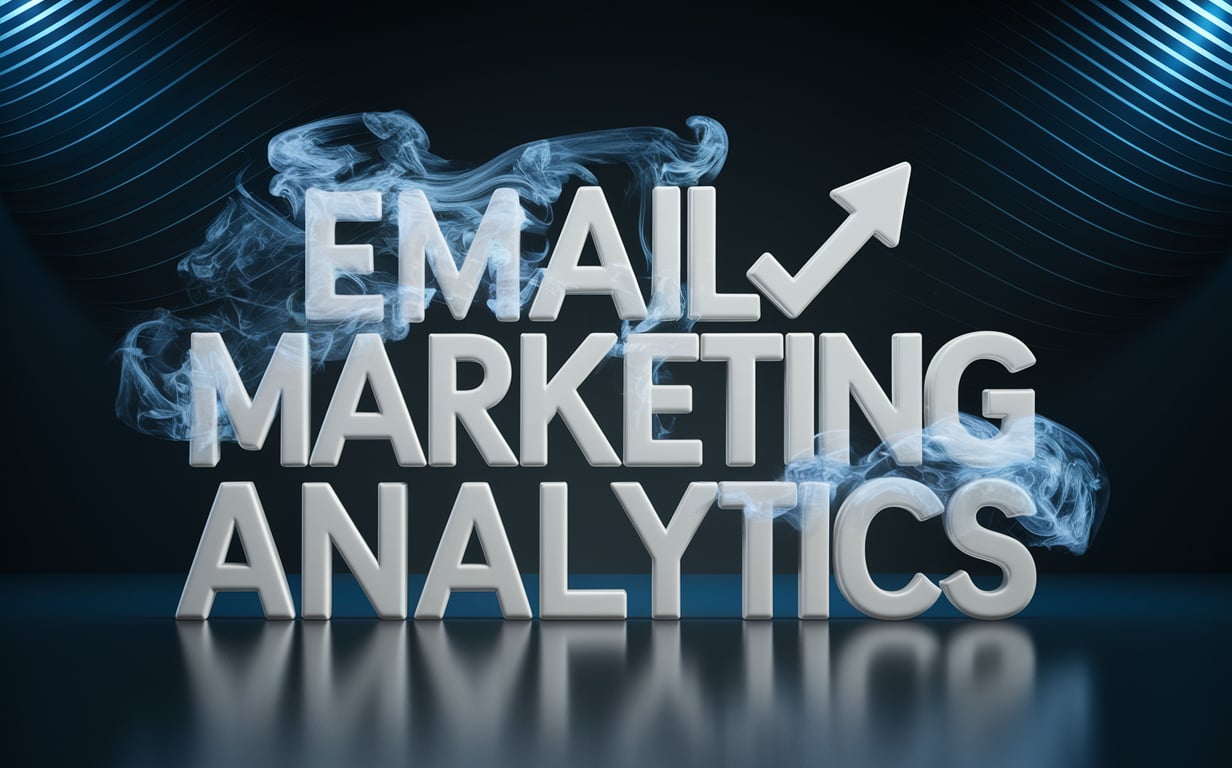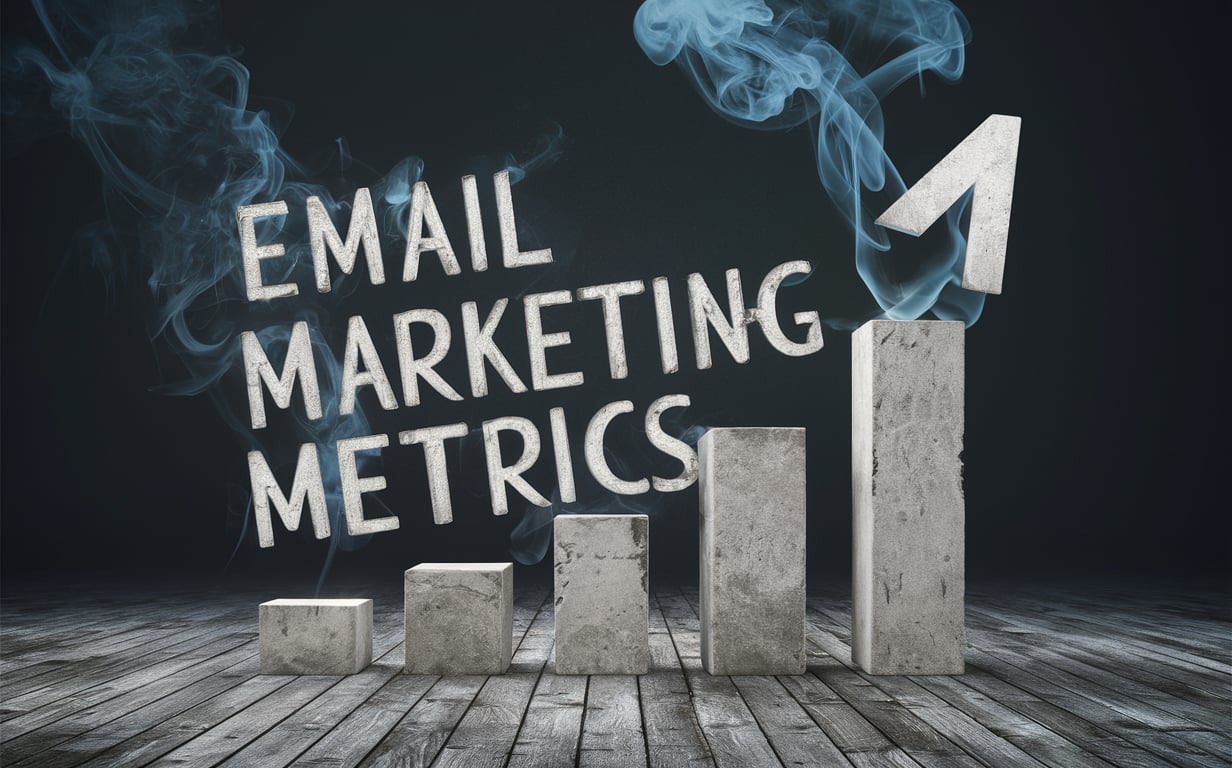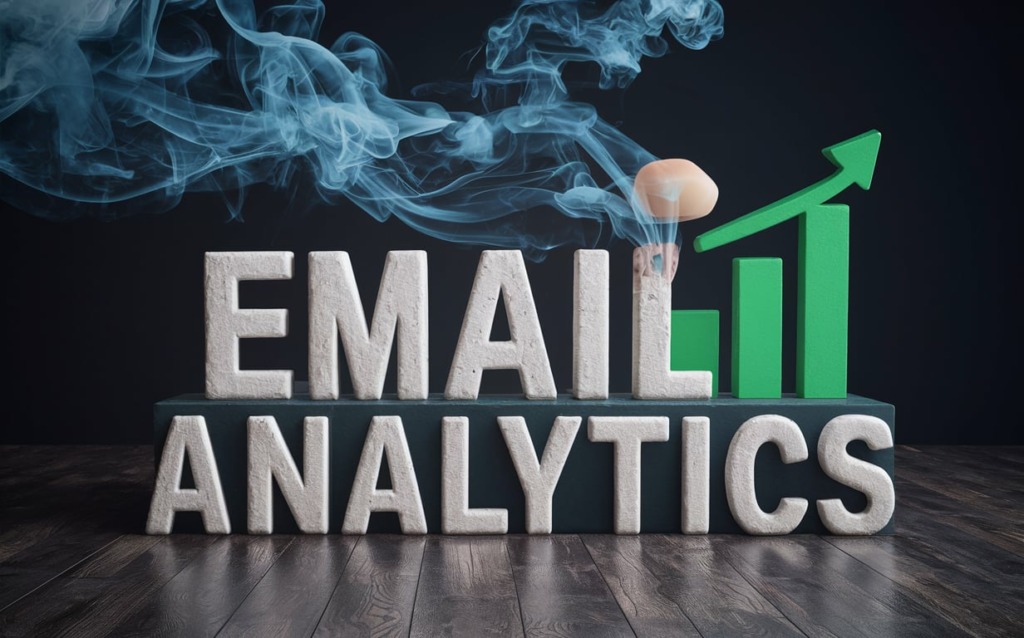Email marketing without analytics is like baking a cake blindfolded. You might luck out, but the odds aren’t in your favor. That’s why harnessing email analytics tools is essential to take the guessing out of your campaigns. Dive into key metrics around opens, clicks, conversions, and more to optimize performance. In this comprehensive guide, learn how proper email data analysis and predictive analytics lift results. Find out which metrics move the revenue needle. Discover tips to extract actionable insights from tools like Mailchimp, Google Analytics, and dedicated platforms. With the strategies in this guide, get ready to boost email marketing ROI through the power of data.
Why Email Marketing Analytics Matter
In the fast-paced world of digital marketing, data is king. Especially when it comes to email.
With inboxes more crowded than a Tokyo subway at rush hour, marketers need every edge they can get to make their emails stand out. This is where email analytics enter the spotlight.
Email analytics provide the cold, hard data you need to take the guesswork out of your email marketing campaigns. Instead of relying on intuition or assumptions, analytics empower you to base decisions on facts.
Here are 5 key ways properly leveraging email analytics can revolutionize your email marketing:
Drives Data-Based Decisions
Email analytics transform your email marketing from an artistic pursuit to a scientific one.
Rather than just going with your gut, you can use data to guide strategic decisions. For example, analytics can show you:
- Which types of content resonate most with your audience
- Optimal send times for open rates
- How your email metrics compare to industry benchmarks
With insights like these, you can fine tune your email marketing process to maximize results. It becomes less about what you think works, and more about what the data says works.
Analytics can even reveal surprising findings that go against conventional wisdom. The data might show that short emails far outperform long ones for your audience. Or that adding emojis to subject lines hurts open rates.
The point is, you don’t know until you actually measure it. Email analytics take the uncertainty out of decision making.
Identifies High-Performing Campaigns
Not all email campaigns are created equal. Analytics provide the proof of which emails are superstars vs. which are duds.
By comparing open rates, clickthrough rates, and other metrics, you can see which campaigns pop and which flop. These hard numbers show what engages your subscribers.
You can then double down on what’s working by:
- Taking successful email content and repurposing it
- Using higher performing subject lines as inspiration
- Leveraging the timing and targeting from winning campaigns
On the flip side, analytics also show what’s NOT working. You can either optimize oreliminate consistently low-performing campaigns that waste resources.
It’s survival of the fittest for email campaigns, and analytics highlight the winners.
Optimizes Email Delivery and Engagement
Getting your email delivered is step one. Getting it opened and clicked is the next battle.
Email analytics shed light on these delivery and engagement metrics:
Delivery metrics:
- Bounce rates
- Spam complaints
- Blacklist statuses
Engagement metrics:
- Open rates
- Clickthrough rates
- Browse rates
- Unsubscribe rates
Monitoring these KPIs daily/weekly shows how your email campaigns are penetrating through the clutter. Poor deliverability or low engagement signals it’s time for an intervention.
You can then optimize your campaigns for relevant content, better segmentation, improved sender reputation, and other engagement drivers. The optimization is guided by the numbers showing where improvement is needed.
Analytics also allow testing of changes to see if they move the needle on delivery and engagement. You gain visibility into what content and approaches connect with your subscribers.
Provides Customer Insights
Email analytics aren’t just about your email campaigns. They also provide crucial insights into your customers.
By seeing how different segments interact with your emails, you gain a clearer picture of customer preferences. This allows more personalized and relevant communication.
Detailed analytics can even highlight insights like:
- Content/offers that trigger purchases
- Times/days users are most active
- Email response rates by demographic
These subscriber insights enable you to tailor emails to “lookalike” audiences. You speak to them in a way that resonates based on real data signals.
List segmentation, email personalization, predictive lead scoring, and other techniques become more powerful when fueled by analytics.
Calculates Email Marketing ROI
At the end of the day, the money matters. Is your email marketing providing ROI or just an empty inbox?
Thankfully, many leading email service providers (ESPs) integrate analytics to track email driven sales and revenue. This makes calculating campaign ROI straightforward:
ROI = (Revenue – Cost) / Cost
Beyond sales numbers, some analytics solutions assign monetary value to engagement metrics like opens, clicks, and leads. This approximates an “indirect” ROI that accounts for moving prospects down the funnel.
No matter how it’s measured, quantifying email marketing ROI through analytics justifies the spend. Hard return numbers also help secure budget for continuous optimization.
So don’t just hope your email marketing pays off. Use analytics to prove the value once and for all.
In summary, leveraging email analytics means making smarter decisions, creating better campaigns, optimizing engagement, gaining customer insights, and driving ROI. Who can argue with that?
The data does the talking. Tuning in and taking action is the key to victory.

Key Email Marketing Metrics to Track
Email analytics are only useful if you’re tracking the right metrics. Like a control panel in a spacecraft, there are specific email KPIs that guide your marketing performance.
While reports can include endless data points, a few vital signs deserve your attention. These are lead indicators of the email health and results that matter most.
Let’s explore the key categories of email metrics to monitor with a guide for what to track in each area.
Delivery and Deliverability Rates
Before your recipients can open or click your emails, they need to actually…receive them. Delivery and deliverability metrics show whether your emails are arriving successfully.
What to track:
- Bounce rate: Percentage of total emails sent that “bounce” or fail to reach the recipient inbox. Aim for less than 2%.
- Spam complaints: Percentage of recipients marking your email as “spam” or unwanted. Goal is less than 0.1%.
- Blacklist statuses: Monitoring of IP and domain reputation on major ISP blacklists like Spamhaus or Barracuda. Goal is no active listings.
- Invalid email rate: Percentage of non-existent or improperly formatted email addresses. Should be less than 1%.
- Email placement rates: Percentage of emails landing in Primary vs Spam vs Promotions folders upon delivery. Inbox placement should be over 90%.
Mastering delivery and deliverability establishes a solid email foundation. Without it, even the most brilliant campaigns go to waste.
Open and Clickthrough Rates
Delivery brings your email to the doorstep. Engagement metrics show who opens the door and steps inside your message.
- Open rate: Percentage of delivered emails that are opened by recipients. Industry average is around 20%.
- Unique open rate: Percentage of total recipients who opened the email. Prevents multiple opens by the same person skewing data.
- Clickthrough rate (CTR): Percentage of delivered emails where the recipient “clicked” on a link. Benchmark is 2-5% typically.
- Unique CTR: Percentage of total recipients who clicked a link in the email.
- Click-to-open rate (CTOR): Percentage of email opens that resulted in a click. Measures engagement of those who opened.
- Browse rates: Percentage who viewed your email content without clicking (if image blocking disabled).
These open and click metrics indicate your headlines and content captivate subscribers enough to take action. Make open and CTR key optimization yardsticks.
Bounce and Complaint Rates
While opens and clicks show engagement, bounces and complaints signal disengagement. But this negative feedback is still valuable.
- Hard bounce rate: Percentage of emails that permanently fail to reach the recipient due to non-existent or invalid addresses.
- Soft bounce rate: Percentage of emails that temporarily fail to be delivered due to a full inbox or other reason.
- Spam complaint (a.k.a. feedback loop) rate: Percentage of recipients who click “report spam” on your email.
- Unsubscribe rate: Percentage of recipients who opt-out of your emails using the unsubscribe link.
These metrics indicate fatigue from irrelevant, unwanted email. Use them to identify and fix engagement issues with your audience.
Unsubscribe and Churn Rates
Beyond one-off unsubscribes, you want to monitor the bigger picture of list momentum.
- Unsubscribe rate: Percentage of email subscribers who opted out of your list during a given time period. Benchmarks range from 0.2% to 0.5% monthly.
- New subscriber rate: Percentage of new subscribers added to your list over time. Aim for at least 2-3% monthly.
- Net churn rate: The rate at which your list shrinks or grows when factoring in unsubscribes and new additions. Goal is at least 1% monthly growth.
Growing and retaining your list ensures future email success. Slow unsubscribe and churn rates reflect quality content subscribers want to receive.
Conversion and Revenue Rates
The pinnacle email metrics relate to money. Are your emails driving conversions and sales?
- Conversion rate: Percentage of delivered emails that led the recipient to take a desired action like clicking an ecommerce link. Varies widely by business type.
- Sales revenue: Total sales dollars generated directly from email campaigns.
- Return on investment (ROI): Total revenue driven by emails divided by cost of sending. Aim for at least 2X-4X ROI overall.
- Email revenue per subscriber: Total sales revenue from emails divided by number of list subscribers. Shows revenue impact of each person.
Ultimately you want to connect emails sent to money made. These conversion and sales metrics quantify the email marketing value chain.
Now you have a trusty blueprint of the must-track email metrics for optimal results. Refer back to this list when configuring campaign reports to keep your eyes trained on the email performance pulse points that matter most.
The metrics act like checkpoints on the race track to guide your progress. Speed up or slow down based on what the numbers say.
With your hands on these email analytics levers, get ready to start optimizing and accelerating campaigns towards the finish line.

Advanced Email Analytics Capabilities
Congratulations, you’re tracking the core email metrics – opens, clicks, bounces, conversions, etc. Now it’s time to unlock more advanced analytics capabilities for deeper insights.
The following techniques help you level up your email game:
A/B Testing Email Components
Take the guesswork out of optimization with A/B testing. This lets you trial run different email variants to see which performs best.
Common email elements to A/B test include:
- Subject lines
- Preview text
- Send times
- Content layouts
- Images
- CTAs
With A/B testing, you gain statistical confidence that Option A outperforms Option B. The winning components can then be applied to boost future campaign results.
For example, AppCompany might test these subject lines:
Subject A: “Try AppCompany’s new video app features”
Subject B: “Enhance your videos instantly with AppCompany”
The open and clickthrough rates reveal Subject B resonates better. AppCompany now knows this style of subject line better attracts its audience.
A/B testing squeezes more impact from your existing email subscriber base. You don’t need to continually find new people to build your list. Just optimize content sent to current subscribers.
Audience Segmentation and Targeting
They say you can’t please everyone. Email analytics help you determine who to please.
Segment your subscriber list into distinct buckets based on traits like:
- Demographics
- Interests
- Past email engagement
Then analyze performance for each segment. This highlights which groups engage best with different email content types and offers.
Armed with these insights, you can tailor and personalize each campaign to align with the preferences of the recipient segment.
For example, an e-commerce retailer might find:
- Men over 40 prefer emails focused on electronics and gadgets
- Women under 30 favor fashion and beauty product offers
Such segmentation and targeting breed loyalty through relevant communication instead of one-size-fits-all blasting.
Email Attribution Modeling
What marketing efforts ultimately led someone to convert from your email? Attribution links online and offline touchpoints.
Using UTM tracker URLs and analytics, you can connect conversions to channels like:
- Organic search
- Paid search
- Social media
- Affiliate partners
- Retargeting ads
- Webinars
This showcases your marketing ROI more holistically vs. siloed campaigns. Resources flow to what’s working across channels to drive email conversions.
You also gain insight into what content and offers convince subscribers to convert after initial exposure elsewhere. This intelligence continually refines high-funnel activities for downstream email success.
Predictive Analytics and Scoring
Harness the power of data science for optimal timing and targeting. Predictive analytics tools apply machine learning algorithms to identify the best recipients and moments for each email.
Predictive capabilities include:
- Propensity modeling: Scores each subscriber’s likelihood to open, click, or convert based on historical behaviors and traits. High propensity segments become “lookalike” targets for future emails.
- Send time optimization: Determines the optimal delivery day/time for each subscriber based on past email engagement patterns. Improves open and clickthrough rates.
- Lead scoring: Assigns points for certain subscriber activities to quantify level of sales readiness. Prioritizes outreach to “hot lead” segments first.
Stacking these advanced applications accelerates results through automation and intelligence. You spend less time guessing “who” and “when” and more time creating winning email content.
In summary, applying techniques like A/B testing, segmentation, attribution, and predictive analytics unlocks the full potential of your email programs. Treat the advanced capabilities as a launch pad to take your email strategy into hyperdrive.
Buckling up is recommended before takeoff.

Powerful Email Analytics Tools
Like a craftsman is only as good as his tools, an email marketer depends on analytics solutions.
Choosing the right platforms and integrating them transforms raw data into insights. Here are popular options to consider:
Built-In ESP Analytics
Leading email service providers (ESPs) like Mailchimp and Constant Contact include robust analytics in their platforms.
Benefits of leveraging your ESP’s analytics include:
- Seamless integration: Native tracking and reporting for the email campaigns sent through the platform. No additional setup needed.
- Consolidated data: Contacts, lists, templates, and performance data are all housed under one roof.
- Customized reporting: Tailor reports to show the exact email metrics you want to monitor and share with stakeholders.
- Real-time visibility: ESP analytics offer an up-to-the-minute pulse check on deliverability, engagement, and conversions.
The main limitation is lack of insight across other marketing channels. But for email-specific analysis, built-in ESP tools often sufficiently fill the need.
Google Analytics Email Integration
Even if you have ESP analytics, it’s wise to also integrate Google Analytics for expanded capabilities:
- Cross-channel insights: See how email complements search, social, and other efforts to drive conversions.
- In-depth segmentation: Apply Google Analytics’ deep segmentation tools to slice and dice email program performance.
- Custom goal and event tracking: Monitor micro and macro conversions across customer journeys.
- Robust attribution modeling: Quantify how each previous touchpoint contributes to email-influenced conversions.
- Email channel reports: Dedicated reports showcase email’s value and highlight optimization opportunities.
With Google Analytics, you transcend siloed email data for complete visibility into multi-channel performance.
Dedicated Email Analytics Platforms
For advanced power users, tools like Mailbakery, Retention Science, and Litmus provide cutting-edge email analytics capabilities:
- Predictive analytics and modeling: Machine learning uncovers hidden insights in your data to guide campaign optimization.
- Advanced segmentation: Combine subscriber behaviors, firmographics, and other dimensions to finely tailor messaging.
- Performance benchmarking: Compare your email metrics to aggregated industry benchmarks for context.
- Cross-channel modeling: Connect email with CRM, web analytics, and other data sources for complete visibility.
- Automated insights: AI-powered analysis highlights biggest opportunities and recommends actions to lift KPIs.
- Email testing and rendering: Review exactly how your emails will appear across different devices and clients.
These sophisticated platforms provide elite-level analytics to maximize the impact of large, high-spend email programs.
Choosing the right email analytics tools provides the fuel to propel performance. As your email marketing ambitions grow, re-evaluate whether more advanced solutions merit the investment to unlock deeper data insights.
Even if you stick with basic ESP reporting, ensure you fully utilize all the available analytics functionality rather than leaving insights on the table.

Tips for Actionable Email Analytics Insights
Like a doctor reviewing medical charts, the numbers alone don’t cut it. You need to properly diagnose and prescribe based on the data.
Turning raw email analytics into true insights requires strategy and rigor. Follow these best practices:
Set Clear KPIs and Benchmarks
Be purposeful in selecting the key performance indicators (KPIs) to monitor for each campaign and audience segment. Common email marketing KPIs include:
- Open rate
- Clickthrough rate
- Conversion rate
- Revenue per email sent
Resist the temptation to monitor every metric under the sun. Identify the precise success measures that matter based on campaign goals and target metrics.
KPIs become even more powerful when coupled with performance benchmarks. As examples:
- Achieve at least a 20% open rate (vs industry average of 15-20%)
- Generate $0.50 revenue per email sent (vs company goal of $0.40)
Benchmarks contextualize your KPIs and help set clear targets for improvement.
Leverage Segmentation and Targeting
Don’t assess email performance at a high level only. The most meaningful insights come from segmentation.
Some key ways to slice and dice your data include:
By audience persona:
- Young professionals – Open Rate: 28%
- IT managers – CTR: 8%
By email type:
- Promotional – Revenue: $2,000
- Educational – CTR: 12%
By campaign content:
- COVID emails – Open Rate: 32%
- Video series – Bounces: 2%
By email platforms:
- Gmail – Clicks: 1,200
- Outlook – Opens: 2,500
Such segmentation uncovers “pockets of value” you can double down on while optimizing weaker areas.
Test and Optimize Campaign Components
Treat email metrics as clues for where to test and iterate. If opens are low, try new subject lines. If CTR is low, test content formatting.
Some elements that impact email performance include:
- Subject lines
- Preview text
- Send days/times
- Content topics/offers
- Layouts/visuals
- CTAs
Run A/B tests to determine what combination of components optimizes engagement and conversions for each audience and campaign type.
Let data guide design rather than assumptions. The improvement comes when you actively apply the lessons learned.
Monitor Trends Over Time
Don’t fly blind. Tracking email metrics over weeks, months, and quarters highlights trends to guide your strategy.
For example, you may notice:
- Open rates dip over the summer
- Promotional emails drive lower ROI than educational content
- Conversions from email surge each year leading up to the holidays
Identifying these seasonality, preference, and other trends means you can better align the timing, content, and targeting of campaigns.
Review metrics regularly rather than one-off to benefit from trend analysis.
Integrate Other Data Sources
Email doesn’t exist in a vacuum. For complete intelligence, incorporate data from your CRM, web analytics, social monitoring, and other sources.
This crossover analysis highlights insights like:
- Traffic referrals driving email opt-ins
- Lower email open rates for recent website visitors
- Email nurturing impact on sales cycle length
Building a holistic customer data foundation ensures context surrounds each email campaign and performance review.
In summary, sharpening your analysis process accelerates the insights yielded from email data. Set clear goals, segment strategically, always optimize, track long-term trends, and connect email to bigger data pictures.
With these best practices, your team moves from merely reporting numbers to truly capitalizing on what the analytics reveal. The difference between middling performance and email excellence comes down to execution.

Get Started with Email Analytics Best Practices
Like any journey, improving email performance through analytics begins with the first few steps.
Follow these foundational best practices to start strong:
Enable Tracking for All Campaigns
This seems obvious, but you’d be surprised how often email tracking is an afterthought.
Activate open, click, and conversion tracking for every single campaign at the time of creation. Consistent tracking ensures you capture the full picture of email engagement and sales impact.
While you’re at it, implement unique URL tags with campaign identifiers to monitor performance for each individual email sent. This enables apples-to-apples comparisons and A/B testing.
Finally, confirm your email analytics solution integrates with any lead capture forms and ecommerce platforms on your website to fully close the loop.
With these basics covered, you have the tracking foundation to yield actionable data.
Schedule Regular Analytics Reviews
What gets monitored gets improved. Set aside dedicated time every week or month for an email analytics review.
Come prepared by pulling the latest performance reports and capturing key takeaways ahead of time. Useful reports to audit include:
- Deliverability and bounce rates
- Open, CTR, and conversion rates
- Sales and revenue contribution
- Trends over prior periods
Share observations, recommend actions based on the metrics, and align on what tests to run. Document next steps for optimizing future campaigns.
Make the discussions collaborative across email, sales, and marketing teams. More eyeballs spot more insights.
Treat every review as a chance to learn and realign strategies with how prospects and customers engage.
Focus on Optimization, Not Just Reporting
Plenty of email marketers celebrate high open rates one month or benchmark topping clickthroughs the next. But did they turn around and optimize anything based on those wins?
Success without action breeds complacency. Set the expectation that every email and analytics review informs what you do next.
Put in place processes to rapidly apply lessons learned through tests and iterations. Don’t just discuss the numbers – act upon them.
Dive into why certain emails delight and drive conversions while others fall flat. Then build on the winners while resolving the losers.
Analytics fuel continuous optimization. Keep your foot on the gas.
Align Analytics Process with Overall Goals
As you determine what metrics and reports to focus on, continuously tie them back to business goals. Common email objectives you can track progress against include:
- Growing list size
- Increasing sales revenue
- Shortening sales cycles
- Improving customer engagement
Connecting the dots between email analytics, campaign strategy, and core KPIs ensures you’re measuring what matters most.
When in doubt, link email success back to broader company priorities. Analytics aren’t performed in a vacuum.
Continuously Refine and Expand Metrics
Don’t get complacent in your tracking. Regularly evaluate whether your analytics methodology fully captures performance and offers actionable insights.
Consider enhancing your analytics approach through steps like:
- Adding new engagement metrics to assess
- Applying more segmentation for deeper analysis
- Strengthening goal and conversion tracking
- Incorporating more data from related systems
- Testing new visualization methods like email dashboards
Proactively look to fill analytics gaps as your email programs mature. The best metrics provide the complete picture.
In summary, instilling these foundational analytics best practices gets your organization’s mindset in the right place. Take the time to lay the tracking, reporting, optimization, and alignment cornerstones needed for data insights to flourish.
The responsibility then falls to you and your team to build up capabilities over time by relentlessly improving and enhancing. Always be learning.
Now that you’re armed with a roadmap of best practices, it’s time to start the email analytics journey. Buckle up and get ready for data to give your email marketing a jolt.

Key Takeaways
Leveraging data and analytics is no longer optional for effective email marketing. Use the strategies covered in this guide as building blocks to bring more science into your email programs:
- Email analytics transform decision making from guesses to facts-driven optimization. Prioritize analytics adoption throughout your team.
- Focus tracking on the vital few metrics like open rates, clickthrough rates, and conversion rates that indicate campaign health and performance. Avoid analysis paralysis from too many vanity metrics.
- Go beyond surface-level reporting. Use segmentation, attribution, predictive modeling, and competitive benchmarking to derive deeper performance insights from the data.
- Choose the right mix of analytics tools – from built-in ESP reporting to Google Analytics integrations and dedicated platforms – to meet your email analysis needs as campaigns scale.
- Make analytics actionable through recurring performance reviews, rapid testing, and fine-tuning campaigns based on lessons learned. Measure for progress, not just posterity.
- Enable complete visibility by connecting email data to your broader marketing and sales tech stack. Holistic attribution is key, as email never operates in isolation.
- Instill analytics best practices across strategy setting, reporting, optimization, and data infrastructure. Maturity takes time, but the payoff can be immense.
The data-driven path rewards persistence. With email analytics as your guide, prepare to steer campaigns in a more profitable direction.
Here are some frequently asked questions about email marketing analytics:
Frequently Asked Questions
Q: What are the most important email metrics I should track?
A: The key metrics to focus on are open rate, clickthrough rate, conversion rate, revenue per email sent, and list growth rate. Monitor these to assess engagement, sales impact, and list momentum.
Q: How much time should I spend analyzing email performance?
A: Dedicate at least one hour per week for reviewing reports and analyzing the latest email campaign data. Monthly or quarterly deep dives into performance are also recommended.
Q: What email analytics tools do I need?
A: Start by using your email service provider’s built-in analytics. Also integrate Google Analytics for wider visibility. Consider adding dedicated analytics software as email programs scale up.
Q: How do I calculate return on investment (ROI) for email?
A: ROI = (Revenue Attributed to Email – Email Program Costs) / Email Program Costs. Multiply ROI by 100 to convert to a percentage.
Q: What are email marketing benchmarks I can compare my metrics against?
A: Average benchmarks are 15-20% open rate, 2-5% CTR, 0.1% spam rate, and 0.2 – 0.5% monthly unsubscribe rate. But benchmarks vary greatly by industry.
Q: How often should I send email campaigns?
A: Ideally send 2-5 emails per month for each subscriber segment. Test to find the optimal frequency based on open and clickthrough rates over time.
Q: What is predictive email analytics?
A: Predictive email analytics applies machine learning to estimate the likelihood of opens, clicks, and conversions based on historical data. This guides send timing and personalization.
Q: How do I integrate email with my CRM platform?
A: Use tracking URLs with UTM tags to connect email performance data back to leads and contacts in your CRM. CRM integrations with your ESP also enable shared workflows.
Q: What is subscriber churn rate?
A: Churn rate shows the percentage of list shrinkage or growth when factoring in new signups, unsubscribes, and deletions of inactive email addresses.

